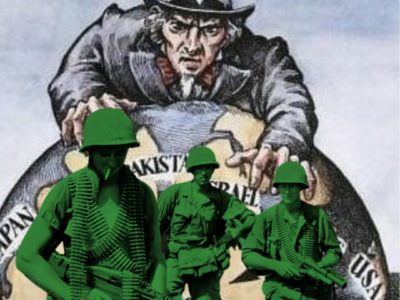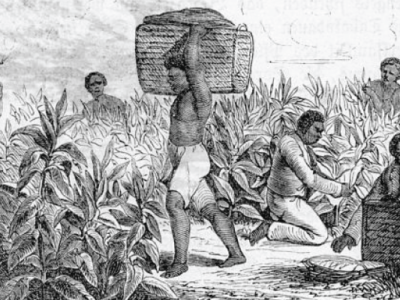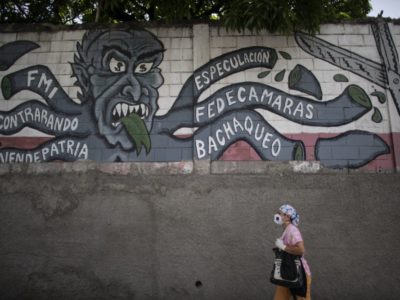With this text, we want to re-examine the established forms of struggle for a better and more just society, as well as to determine whether they correspond to the existing historical conditions. Our goal is start a debate on new forms of anti-imperialist action. Forming a political party, participating in parliamentary elections, mass organizing through civic and other organizations to develop mass support in the struggle for power over the state apparatus–all this is taken for granted when it comes to trying to make a revolutionary change towards a society without exploitation, towards ownership and production relations in the service of citizens, and not in the interests of the accumulation of capital.
History teaches us that the mentioned approach was successful and bore fruit, but we are also witnessing the disappearance of a number of societies which, in an attempt at revolutionary social transformation, failed to adapt the struggle to the new conditions that arose from the development of global capitalism. The question is which experiences of these societies offer us a positive and which a negative example. If we focus only on the positive, pretending that the negative does not exist or that they are a matter of conspiracy, we are threatened with the repetition of the same mistakes and a fate not much different from the fate we experienced in the 80s and 90s. They also raise the question of the applicability of the methods of struggle from an epoch in which the social, economic and general historical situation was qualitatively different from today. In order to be able to answer the questions asked, we must start by getting acquainted with the characteristics of the economic and political system of today.
Characteristics of the economic basis of modern capitalism
Three roughly divided periods are important for our consideration to understand how capitalism has changed from the period of the first socialist revolution to the present day:
- the colonial period crowned with two world wars for partition that ended in 1945,
- neocolonial period until the mid-70s,
- the neoliberal period of global capitalism.
Until the end of the Second World War, the main form of accumulation of wealth in the imperialist countries was through colonialism: the military occupation of the territories of other peoples and their subjugation. Colonialism was primarily based on force–territories outside Europe were occupied by military campaigns to facilitate operation of private companies (such as East India Company); the peoples found on the conquered land were subjugated by the colonizers and forcibly drawn into capitalist production in several ways: by seizing land and deposits of raw materials, by turning them into slaves, or by forced unpaid or poorly paid labor. Politically, the colonies were part of the metropolis and completely under the rule of the colonizers, while the economy of the colony was subordinated to the economic needs of the metropolis.
During this period, there was a conflict between the imperialist powers over the division of the colonies in the form of two world wars. Their political outcome is the end of direct rule over the colonies relying on military force, which is replaced by formal political independence with economic dependence, ie. the so-called neocolonialism. Thus, although the former colonies became sovereign states, they were still tied to the metropolis by a structure of economy that was completely subordinated to the economic interests of the colonizers. Among other things, during the period of colonisation, their economy was transformed in such a way as to provide cheap resorces for the metropolis. One example of it is the cash crop production, such as cotton and sugar via African slave labour. Although slavery and dependency were abolished, the economic infrastructure was inherited and it imposed the constraints on future economic development. In addition to economic dependence, there is usually military dependence in the presence of the troops of the metropolis with the pretext of cooperation and aid. Effectively, they achieved independence and national liberation, but they could not overcome the constraints of the capitalist system which blocked their transition to economic liberation.
At the end of the colonial period, more precisely after the market collapse in the USA in the 1920s, this country switched to the economic model of John Maynard Keynes, which was based on state intervention, ie. creating demand that stimulates the economy by creating new jobs and raising incomes– then, the increased incomes, in turn, increase consumption which further stimulates the economy, growth and development. This policy was accompanied by the organization of production according to the principles of Henry Ford: it was a centralized production in factories with a large number of workers and standardized products.
Fordism and Keynesianism lead to the so-called class compromise in the West–to the creation of a welfare state in which the profits are redisributed to workers through high salaries and various state programs such as pensions, health and education funds. The profit is obtained by transferring value from the neo-colonies that produced raw materials for processing in the factories of the metropolis.
This model dominated until the 1970s, when it became an obstacle to further capital accumulation. Then came the third period, the current period of neoliberalism. At the domestic level, the countries of the center began with the abolition of the welfare state and the abolition of workers’ rights, while at the international level, the relations are being transformed so that they lead to the abolition of protectionism and easier capital flow. Countries that cannot repay their debts are imposed with so called Structural Adjustment Programs. They are designed remove all barriers to penetration of country’s local market (the barriers that protect domestic producers), to require privatization of state property, and to reduce government spending on social protection programs. Among other things, they are meant to enforce the international laws that would protect the intellectual rights and property of investors. This allows transnational corporations to transfer jobs and technology from center to peripheral countries and protect that investment. Ultimately, SAPs lead to informalisation and impoverishment of the local labour.
Although from the beginning of the modern capitalist system we can talk about the global division into the bourgeoisie and the proletariat at the world level, from the beginning of neoliberalism we can also talk about the creation of a transnational capitalist class, that is, a class of capitalists whose interest is to remove all barriers to the flow and penetration of capital, as opposed to a local capitalist class whose interest is to protect themselves by protectionist measures. This transnationalist capitalist class also forms and controls transnational organizations that institutionalize the neoliberal order, such as the World Bank, the World Trade Organization, the International Monetary Fund, and so on.
From this brief overview, we can see the main aspiration in global capitalism: the ability of capital to move freely around the world. Whether it is financial or industrial capital, there are almost no borders for it, and where there are, neoliberalism tends to break them and assimilate new territories into the world market. However, the same cannot be said for workers and workers’ struggle.
Apart from the fact that the workers are prevented from working on the market of foreign countries, they also focus the struggle exclusively on local, national issues. From the very beginning of modern capitalist system, the workers of the countries of the center were connected with the workers of the periphery through global commodity chains, and over time, that connection deepened. Commodity chains refer to the whole production process from extraction of raw materials, shipping, processing, assembly and sales. This process involves thousands of workers over the world, and over time grows in complexity. Despite this connection, the labor of one country neither participates nor knows about the struggle of the labor of other countries.
Global commodity chains are production networks in which each node produces one component of the final product, starting from the extraction of raw materials, processing, production of the semi-finished product, assembly, distribution, marketing, etc. The nodes can be located in geographically different areas (for example, coffee is produced in Latin America and roasted in the countries where it is sold), and it also contains specific social and production relations that determine the distribution of value created. If we look at the commodity chains through these three periods, we can see that the production chains were initially relatively short (raw materials from the colonies or neo-colonies, and production in the metropolis), but over time they branched out around the world in the measure the capitalist world world market expanded (for example, General Motors has a network of over 20.000 parts suppliers from around the world).
The deepening and expansion of commodity chains is also a manifestation of the way in which capital neutralizes the resistance of organized labor to exploitation. Workers’ struggle for greater rights, higher wages, better protection, redistribution of wages, etc. leads to a decline in the rate of profit of capitalists, which is why they are looking for ways to reduce costs by replacing the labor of one country with cheaper labor of another country. In particular, by exporting jobs or simply abolishing them, followed by entering into a partnership with companies on the periphery that would replace expensive local workers at lower costs. Jobs are exported to special economic zones where companies (but not workers) are tax-exempt, union organizing is prohibited, and local workers’ protection laws do not apply. This process is repeated in semi-peripheral and peripheral countries if the price of labor rises enough to create an obstacle to the accumulation of capital.
From the historical experience of the previous anti-imperialist and anti-colonial struggles, we can conclude that their main failure was to build global (or transnational if you wish) organisations with anti-systemic character of collaboration and common struggle with other countries in a similar situation. It can be concluded that localized workers’ organization is insufficient to win the battle against exploitation efficiently and in the long run. This lack of organized struggle outside national borders can be supplemented by divisions within borders.
Internationalism or transnationalization?
The Manifesto of the Communist Party itself established the necessity of a global struggle with its slogan: “Proletarians of all countries, unite!”, and the consequence were the First, Second and Third Internationals which brought many victories to the class struggle, but also pointed out the contradictions of the struggle within international and national frameworks. The very fact that the Third International was created on insistence of a part of the social democratic parties of the Second International to support the national bourgeoisie in the imperialist war of division speaks volumes about the scale of these contradictions.
What is the difference between internationalism and transnationalism? Internationalism refers to the priority of the national class and political struggle over the global struggle, where it is expressed primarily through solidarity and cooperation. The transnational struggle has aimed at a single global struggle from the very beginning.
Here are a few examples. During the Third International, which aimed at national liberation and decolonization, the communist parties of England and France did not oppose the colonialism of their countries nor did they support national liberation movements (in some cases they actively criticized them) out of fear of alienating their country’s workers. For them, the goals of the world revolution were of secondary importance in relation to the local political struggle, and therefore becaming an accomplice of colonization and imperialism. Another example are the American trade unions, whose class struggle to protect the interests of workers maintains import barriers, which also fills the state coffers, and is to the detriment of super-exploited workers in Asia.
This reflects the contradictions of nationalism within the communist struggle. Nationalism within states of Global North only strengthened the economic interests of the workers in social-imperialism, while in the Global South is was the force behind anti-colonial struggle aiming at building a socialist future.
In a world that is tightly interconnected and integrated, this “national internationalism” is becoming a dead end, as the history shows us that bright examples of internationalism are related to those cases when countries and movements neglected personal interest by subordinating it to the interests of global struggle. For that reason, we consider “transnationalism” to be the essence of the internationalist idea of the Manifesto of the Communist Party and the only form of organizing the principled anti-imperialist struggle.
Anti-systemic movements
To explain anti-systemic movements, it is necessary to first define the system itself. Starting from Lenin’s work “Imperialism as the last stage of capitalism” and new theoretical developments within the theory of dependency, world-systems analysis and Global Capitalism School, we consider imperialism to be a system which includes economic and military-political order in the form of a hierarchy of state, within which the surplus drain takes effect from bottom up. When we talk about imperialism as a system, we are not just talking about certain aggressive policies of the richest countries, because we believe that international political relations, military conflicts and interventions, cultural and ideological domination are based on the structure of global capitalism. In other words, global capitalism is a disease, while the aggressive policies,the relationship of dependence and dominance are its symptoms–no matter how much the symptoms subside, the disease still remains.
An anti-systemic movement, as the name suggests, is considered to be any kind of movement, revolutionary or not, whose struggle or resistance changes the structure of the system. Anti-systemic movements can be revolutionary movements like those that transformed the system with the Russian and Chinese revolutions, then national liberation movements like the Vietnamese, Cuban and a series of African ones that led to the system crisis, as well as indigenous movements that resist integration into neoliberalism like Bolivia.
Equally important is to understand that the biggest portion of the left-wing and progressive movement in the Global North aims at preserving the capitalist system, i.e. the very structure of imperialism. For this reason, it is important to emphasize that certain movements may have an anti-systemic role, although this is not their explicit goal, while some others can have progressive outlook while they have the role of maintaining the system and status quo. For example, indigenous ethnic movements may resist integration in order to preserve their collectivist way of life and control resources. By resisting integration into market flows, they block the expansion and deepening of the system; by denying resources such as lithium in Bolivia, they are blocking its further economic development, disabling initiatives such as the Green New Deal aimed at overcoming the crisis at the center, and maintaining a collectivist tradition and culture creating an alternative to the system, undermining its legitimacy and ideological hegemony. The movements with anti-systemic potential are those that aim to resolve the issues that stem from capitalist system and which are necessary for its reproduction. Such issues are racial, ethnic and genderd polarisation aimed at discrimination and superexploitation; then the issues of ecology and environment.
For an anti-systemic struggle to be truly anti-systemic, it must be a struggle for a non-capitalist basis of production and for a break with the system–therefore, anti-capitalist and against integration. A socialist revolution in a country that would remain part of the system, but would still participate in production chains, would be completely subordinated to the mechanisms by which that system works and, even if not dependent on foreign capital, it would have to compete in the global market, which means implementation of all exploitative and discriminatory practices related to the capitalist world economy, both over one’s own and over the labor of other regions in the chain in which it participates. Thus, with integration into global capitalism, it is not possible to eliminate the source of inequality and exploitation, and without socialism it is not possible to build an economy outside the system of global capitalism.
The historical experience of revolutions in the Third World shows us that an alliance between classes is necessary for the success of anti-systemic movements. However, a simple division into capitalist and working class is not enough because it is difficult to see through them the details related to their composition depending on the zones of the system, ie. from the position of a particular country or region in the system hierarchy. If we start from the fact that the members of the proletariat are those who live exclusively on wages, and the capitalists are those who own or participate in the means of production, then we can conclude that the executive director of a multinational corporation with a million dollar bonus and a Chinese peasant that works in Foxconn are equally exploited, or that a member of the board of Amazon is somehow on a par with a shoemaker.
At the national level, we can distinguish between workers who may not be formally owners of the means of production, but who manage and dispose of them, with incomes as if they were in fact owners. Then: the middle class of workers employed in specialist positions; fully proletarianized workers in the formal sector–workers whose income is entirely from wage labor, and that work is done within the legal framework established through the class struggle; proletarianized workers in the informal sector–those whose employment status is not fully regulated, which allows companies to partially reduce costs by transferring them to labor (a typical example is undeclared work, unregistered immigrants, but also small entrepreneurs who to their detriment and in favour to competitiveness do not meet the law norms that would increase their costs); finally, semi-proletarians–a group of workers whose income from the formal or informal sector only partially covers the need for survival, and the rest is supplemented by subsistence agriculture.
This class division does not mean that all its strata are equally present in all zones of the global capitalist system. Global production requires that these class strata be viewed on a global rather than a national level. There are certainly no semi-proletarians in the imperialist countries, and the middle class of specialists is mostly concentrated outside the dependent countries. With the interconnectedness of production we come to a direct connection of class relations, where it is clear that gross values are created by semi-proletarians and their households, then proletarians in the informal and formal sectors, respectively, and that the upper classes, especially those in imperialist countries, can actually create less value in comparison to the one they receive as a reward for their work. In the case of semi-proletarians and proletarians of the informal sector, we are talking about super-exploitation–exploitation rates that are higher than average, while in the case of specialists, we are talking about super-salaries (salaries bigger then the value produced). In the first case, part of the superprofit (high profit realized by superexploitation) is transferred to super-salaries, which means that specialists have a material interest in the exploitation of semi-proletarians and informal proletarians.
Why is the peasantry not mentioned? Peasantry is a key element of semi-proletarian households, in that they are with one foot in the field and the other in the factory. Likewise, the peasantry that has lost its land is the main “reserve army” of informal labor. At the same time, the peasantry, like the working class, is included in commodity production chains, so we do not consider them separately from the context of the global class struggle.
Hence the conclusion: it is necessary to define a global class alliance of those strata whose interest is anti-systemic action. These are undoubtedly semi-proletarian and proletarian strata, with the focus shifting from the formal proletariat to the informal. Certainly, as the informal sector expands and draws in more and more workers, and this is a global process, so will its role grow even among the upper classes who are losing the benefits of super-salaries.
Transnational anti-systemic movement
Against global capitalism, a global struggle. That is the goal, and our method is the transnational anti-systemic movement as a coordinated struggle of the class alliance of those layers on whose work the world’s wealth rests.
We need a global perspective on the anti-imperialist struggle. This means being able to identify the principal contradiction in global capitalism and to determine how it affects our national and international struggle. This analysis should produce a strategy and tactics of action, which moves the contradiction towards our anti-systemic goal.
The forms of the transnational struggle can be multiple: transnational trade union struggle (across global commodity chains); transnational climate and ecological struggle; transnational anti-racist, anti-fascist, anti-colonial struggle; global movement for basic living conditions…
How do we organise it in practice?
A transnational anti-systemic movement should represent a global network with a minimal hierarchy (so-called diagonalism) through which participants, whether movements, individuals, communities or states, would share experiences and information; coordinated protests, strikes and demonstrations; mobilize solidarity and support; in short, which would organizationally erase the boundaries between isolated struggles and connect them into one world struggle. There a number of questions to answer: who will be delegates? How do we put Samir Amin’s proposal in practice as to how to transition from discussion towards action? What are the forms of struggle that should be accepted: parlamentarian, extra-parlamentarian, armed struggle, civil disobedience?
This approach also has challenges. Principled anti-imperialism requires steps that may be contrary to the short-term interests of the local struggle or even undermine the material interests of activists of certain movements. To cite an example: the Spanish shipyard Navantia produces ships for Saudi Arabia that are used for aggression against Yemen, which is why public opinion demanded that the agreement with Saudi Arabia be terminated. The response of the Arab monarchy was a threat in the form of retaliation that would deprive Spain of a series of contracts that would leave hundreds of workers without jobs. The first to rise up against the termination of the agreement were the unions and representatives of the “progressive” parties in power in the place where Navantia is located, under the pretext of protecting jobs.
It is in vain to seek a solution to this contradiction in the imperialist countries. It is actually, as always, only when the problem is seen globally and realizes that the anti-systemic struggle can hardly come from a region whose well-being depends on the poverty of other regions. So, the solution is in the alliance of the region whose interest is opposite to the interests of maintaining the system.
We can also say that in dependent countries there may be a conflict of interest of (formal) proletarians who base their relatively higher status in relation to informal and semi-proletarian workers on integration into the imperialist system, while the fight against the system would call that situation into question. Let us corroborate this with a recent example from South America in which we witnessed that trade unions (legal formal workers) gave a weak, if any, response to mass mobilizations led by discriminated indigenous communities that have the social status of semi-proletarians.
Certainly, challenges and contradictions will appear, but they can be resolved precisely through the very network of the transnational anti-system movement, as already mentioned, by exchanging experiences and coordinating joint action.
We are aware that this is a very abstract idea with little basis in practice other than the lessons offered to us by the history of the proletarian struggle. We are also aware that most movements put national and local struggle in the first place in relation to international struggle. The process is long and arduous, but the first step is necessary.
Acknowledgments: we would like to thank everyone who contributed to this article with review, ideas and criticism.
References:
Amin, Samir. “It is Imperative to Reconstruct the International of Workers and Peoples”.
Amin, Samir. “Unequal Development”.
Chase-Dunn, Christopher. „Forging a diagonal instrument for the global left: the vessel“
Chase-Dunn, Christopher. “Global Formations”.
Chase-Dunn, Christopher. “Social Change”.
Clelland, Donald. “Imperialism and Global Value Transfers“
Communist Working Group. „Unequal Exchange and the Prospects of Socialism“.
Cope, Zak. „Divided World, Divided Class“.
Cope, Zak. „The Wealth of Some Nations“.
Dunaway Wilma. „Ethnic Conflict in the Modern World-System: The Dialectics of Counter-Hegemonic Resistance in an Age of Transition“
Emmanuel, Arghiri. “Unequal Exchange”.
Foran, John. “Taking Power”.
Frank, Andre Gunder. “Development of Underdevelopment”.
Frank, Andre Gunder. “Lumpenbourgeoisie and Lumpendevelopment”.
Gereffi, Gary. “Global Commodity Chains”.
Lauesen, Torkil. “Global Perspective”.
Lauesen, Torkil. “The Principal Contradiction”.
Robinson, William. “A Theory of Global Capitalism”.
Smith, John. „Imperialism in the Twenty-First Century“
Wallerstein et al. „Anti-Systemic Movements“.
Wallerstein, Immanuel. “Commodity Chains in the World-Economy Prior to 1800”.










